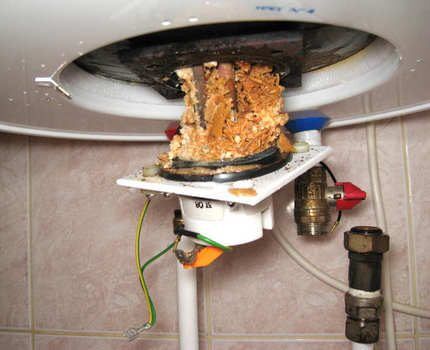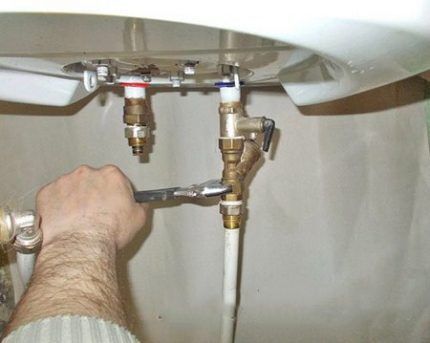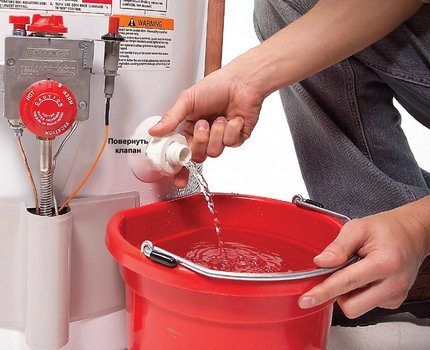How to drain water from a water heater: pros and cons of different methods + example of work
In theory, the question of how to drain water from a water heater seems very simple and elementary.However, in practice, not all home craftsmen can immediately cope with the task quickly and correctly.
To avoid difficulties and avoid fatal mistakes, it is advisable to have a detailed description of the process at hand and strictly follow all instructions. Then the work will not cause much trouble and will not affect the subsequent functioning of the water heater.
We will help you resolve this issue. The article describes common situations that require draining water, and provides methods and rules for emptying a water heater. The information presented will be an excellent help to the home handyman when servicing the boiler and replacing the heating element.
The content of the article:
Structural features of the storage tank
A water heater is a popular household appliance. To function fully, it needs correct operation and scheduled maintenance.
Manufacturers and equipment suppliers strongly advise users not to empty the container of water unless absolutely necessary and to keep it empty for a long time. In such a situation, the internal space of the tank is occupied by air, which negatively affects the surface of the tank and the general condition of the heating element.

More expensive units, made of stainless steel and equipped with a dry heating element with a progressive ceramic coating, are resistant to air, but the bulk of cheap budget models do not have any protection and, remaining empty for a long time, then fail and require replacement.
Therefore, experts recommend keeping them filled and not draining water unless absolutely necessary.
When drainage is required: popular reasons
Reason #1. The water heating tank needs to completely drain the liquid if the room where the equipment is located is not heated for a long time.
For example, it could be a summer house that is not suitable for winter living, or any other property that is rarely visited by the owners, where the average temperature drops below +5°C.
In this mode, the water in the storage tank and pipes may freeze and there is a risk of damage to the internal structure of the container and piping. Therefore, it is better to carefully drain the liquid in advance, and mothball the system until a more appropriate time.

If it is expected that the device will not be used for a long time, then the contents in it can be updated once every 2 weeks by opening the hot tap on the mixer for a few minutes.This way the water will not stagnate and harmful microorganisms will not appear in it.
Reason #2. Routine cleaning is another good reason to completely empty the boiler. It is carried out once a year where water of a high level of purification, containing a minimum of impurities, is centrally supplied.
Twice a year the tank is cleaned with the constant use of running water entering the system directly from the tank and not passing through treatment manifolds.

In addition, during operation, dirt and harmful bacteria accumulate inside the boiler, and the bottom, walls and heating element become covered with scale. As it settles on the heating element, it turns into a kind of heat insulator.
Then the following situation develops: the device itself becomes very hot during operation and begins to overheat. In this case, running water practically does not change the temperature and enters the system barely warm.

The efficiency of the unit drops to a minimum with intensive electrical consumption. To fix the problem, you need to drain the tank, remove the heating element and clean it of scale. Then, in the near future, the equipment will be able to fully operate and the water heater will not need to be completely replaced for a very long time.

Reason 3№. Emptying the tank may be necessary when the unit has already expired, but one of the working components has broken down.
For DIY repair or replacing the heating element or the magnesium anode will have to be completely drained of water, carry out all the necessary repairs, then reconnect the equipment to the system and fill it with fresh water.

More information about possible boiler breakdowns and how to eliminate them is written in this article.
Reason #4. Another serious reason for draining water is the unpleasant odor emanating from the tank. It usually appears when the equipment is used very rarely. Water that is in a container without regular renewal stagnates, begins to silt and smell.
After the tank is completely emptied and filled with fresh liquid, the “aroma” disappears and no longer bothers residents with unpleasant fumes.

Reason #5. In addition to all the reasons listed above, emptying may be necessary if the tank is dismantled and moved to another location, for example, during redevelopment of the premises and ongoing major or cosmetic repairs.
When is it not necessary to drain water?
It is not necessary to drain the water heater and leave it empty in all cases. When planning to “mothball” equipment for a long period, for example, throughout the summer, it is better to leave some water inside the container.
It will prevent early corrosion from forming and will protect the unit from fire if the owners suddenly return and accidentally, through carelessness, turn on the empty heater.
When there is a desire to get rid of stagnant water that has become stale during equipment downtime, there is no point in carrying out a complete draining operation. It is better to refill the container several times and refresh the contents of the tank.
By the way, experts strongly recommend carrying out this procedure once every 2-3 months, passing at least 100 liters of cold running water through the device for rinsing.
It is highly undesirable for a home mechanic to enter a boiler that is under warranty. If, after a system leak, you need to contact a service center, no one will carry out warranty repairs.
Traces of interference will be so obvious that employees, noticing this, will immediately cancel the grace period of service and will no longer provide free services.

You should not flush the water just to see the internal structure of the tank or to learn in such a way that in the future you can do everything yourself, rather than resort to the services of highly paid craftsmen. It is better to carry out work only when absolutely necessary. Then the equipment will work fully and will not cause any trouble to the owners.
Where to start the process
Regardless of which company the water heater is used, in order to carry out the draining process correctly, you must disconnect the unit from the electrical network before starting work. This will protect the equipment from short circuits, and the technician will avoid potential injuries.

Then you should use the valve to shut off the flow of tap water into the tank and leave the boiler turned off for a while so that it cools down completely. When these parameters are met, you will have to carefully remove the tubes supplying hot and cold water, and only then proceed directly to draining.
Description of popular methods
There are different ways to drain liquid from a water heater. All of them are not too complicated and work on the same principle. Minor differences are due only to the design features of the boilers used.
The work does not take much time, but it requires accuracy, pedantry and thoroughness from the home craftsman. If you approach the issue carefully and responsibly, the process will go smoothly and will not have a negative impact on the design and subsequent performance of the equipment.
Drain through safety valve
The communication system, which includes an initially correctly installed water heater, assumes the presence of a drain safety valve. It is usually located on a cold pipe or rod just before entering the tank. This element is intended for emergency drainage of water from the boiler tank.
The draining process occurs spontaneously when, for some reason, the pressure inside the tank exceeds the established safe level. The emergency valve itself is equipped with a screw handle and a special spout, to which it is very convenient to attach a drain tube.
The node's performance is checked monthly. To do this, open the valve handle and wait for some time. Water flowing out in an even stream shows that the valve device is in working order and fully performs its functions.
If the water flows very weakly or does not flow at all, then the channel is clogged and the valve does not perform its direct safety function. Having received such information, it is better to immediately react and clean the element for further full-fledged work.
When a part can no longer be cleaned, it is recommended to replace safety valve on new.

Draining water using a safety valve is considered the simplest, most accessible and inexpensive. To implement the process, you only need to turn the valve responsible for the emergency device.When the valve is working, water will immediately flow out of the spout or outlet hose attached to it.
The owners will only have to wait until all the water has drained, and then perform all the necessary manipulations with the boiler: preserve it for the winter, replace faulty parts, eliminate the unpleasant odor, perform scheduled cleaning, etc.
Emptying the tank through the cold water hole
Draining liquid from a water heater through the cold water outlet is more complicated than described above, and requires attention, a responsible approach, and some working skills from the home technician.
To carry out the task, you will have to arm yourself with an adjustable wrench and unscrew a certain number of nuts that ensure the integrity of the structure.

Step-by-step instructions, created by professionals for home craftsmen, recommend proceeding in the following order:
- Disconnect the boiler tank from the power supply and shut off the supply of cold and hot water to the room.
- Make sure that the hot tap is closed, otherwise, after unscrewing all the nuts, the water will flow excessively and will definitely flood the kitchen.
- Place a container of suitable size under the storage tank to drain the working water.
- Unscrew the nut connecting the safety (drain, check or emergency) valve and the metal-plastic communication pipe (or flexible hose).
- Using an adjustable wrench, carefully unscrew the nut securing the safety (relief) valve and the heating unit nozzle.
- Remove the relief valve and assess its condition. If a blockage is detected, thoroughly rinse the part under running water.
- Open the hot water valve and allow air to enter the sealed tank. After these manipulations, water will flow from the cold pipe much faster.
- A hot tap will help regulate the level and strength of the flow. If the discharge is too strong, the valve can be tightened a little.
- If your service system has a drain valve installed on the hot spigot, you can use it to control the drain level without using a standard hot tap.
Provided that everything is done correctly, the water from the heating tank will drain completely in 3-5 minutes, depending on the volume of the unit.
Draining water through hose holes
You can empty the water heater very quickly by draining the working fluid through the hoses responsible for the supply/discharge of cold and hot water. However, this method is only suitable for those units that are located directly above the bathtub. There are no functions for controlling the force and speed of drainage in this option.

To activate the process, you need to unscrew and remove the cold water hose and safety valve from the inlet pipe. Then remove the hose from the hot water connection.
All the liquid present in the tank at that time will drain into the bath in literally 1-2 minutes and the unit will become available for routine cleaning, routine repairs and complete shutdown for the purpose of preservation for the winter.
How to remove residual water
Regardless of how the water is drained from the water heater, it will not be possible to remove it completely and without any residue. This is due to the design features of the boiler tank.
To remove every last drop, you will have to almost completely disassemble the unit, clean the internal surface, eliminate faults, and then either mothball the system until the next use or reassemble the unit, return it to its place and continue operation as usual.
Rules for completely emptying the boiler
It is necessary to drain the bulk of the water using one of the methods described above that is most convenient for you. Carefully unscrew the decorative cap located at the bottom of the tank.
Holding it with your fingers, carefully disconnect the wires holding the signal lamp to the surface. Then also remove the electrical wires, after remembering their exact location.

Then slowly and counterclockwise unscrew the flange that supports the heating element. Gently loosen the nuts of the structure and allow the remaining water to flow out of the boiler tank. Finally, completely unscrew the nuts and remove the flange. Very slowly remove the heating element from the recess, trying not to damage either the surface of the tank or the part itself.

Pour out the remaining drops of water from the boiler, clean the surface, and then reassemble the unit, install it in the communication system and begin using it in standard mode.
Tools required for work
The process of emptying water heating units from different manufacturers is very similar in basic principles. The main tools required for correct operation are a traditional adjustable wrench and a rubber hose designed to drain the liquid.

For servicing some models of boilers, for example, "Ariston", "Electrolux", "Termex" etc. screwdrivers with different-sized bits, a wrench and a hexagon will come in handy.
It is appropriate to lower the hose for draining the liquid into the bath. If this is objectively not possible, you will have to find a practical and convenient capacious container into which waste water will flow during the process of emptying the boiler.
Conclusions and useful video on the topic
A simple and affordable way to drain liquid from a boiler. A complete procedure, interesting tips and tricks from a professional master.
A detailed description of how to easily and quickly drain water from a storage boiler in order to then replace the old heating element with a new one. A step-by-step description of the workflow, indicating all the tools used.
How to properly drain water from a storage tank and clean the inner surface of the container and heating element from the resulting scale, dirt and heavy water deposits.
The process of draining liquid from a water heater is not too complicated, but it requires attention, accuracy and clear, streamlined actions. By strictly following the above instructions, even an inexperienced home craftsman who has never encountered such work before will be able to cope with the task.
Next time, emptying the boiler will no longer look problematic, especially since it is not recommended to drain water from the storage tank regularly, but only in case of urgent need due to the reasons described above.
Do you have experience draining water from a water heater? Or want to ask questions on the topic? Please comment on the post and participate in discussions. The feedback block is located below.




The easiest option is to open the tap in the kitchen or bathroom. No effort required. We turn off the water supply to the boiler, open the hot water tap and wait until everything drains from the system. The only bad thing is that this method works for boilers with the inlet and outlet located at the bottom. If the connection is organized from above, you will have to come up with some other way. I personally emptied the container using a thin hose.
I had a case: the water supply valve on the boiler broke. The supply did not stop.When I got home, the entire floor was flooded and water was seeping through the bottom of the boiler. It was not possible to fix the problem quickly on our own. The first thing that came to mind was to turn off the water supply to the apartment. But it continued to ooze. Good thing I had a relief valve installed. True, I drained the water for an hour and a half. Afterwards I had to call a repairman.